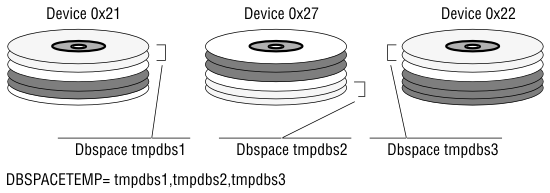
This section discusses using multiple disks for dbspaces, logical logs, and temporary dbspaces.
A dbspace can include multiple chunks, and each chunk can represent a different disk. The maximum size for a chunk is 4 terabytes. This arrangement allows you to distribute data in a dbspace over multiple disks. Figure 22 shows a dbspace distributed over three disks.

Using multiple disks for a dbspace helps to distribute I/O across dbspaces that contain several small tables. Because you cannot use this type of distributed dbspace for parallel database queries (PDQ), it is recommended that you use the table-fragmentation techniques described in Designing a Distribution Scheme to partition large, high-use tables across multiple dbspaces.
You can distribute logical logs in different dbspaces on multiple disks in round-robin fashion to improve logical backup performance. This scheme allows the database server to back up logs on one disk while logging on the other disks.
Keep your logical logs and the physical log on separate devices to improve performance by decreasing I/O contention on a single device. The logical and physical logs are created in the root dbspace when the database server is initialized. After initialization, you can move them to other dbspaces.
To define several dbspaces for temporary tables and sort files, use onspaces -t. When you place these dbspaces on different disks and list them in the DBSPACETEMP configuration parameter, you can spread the I/O associated with temporary tables and sort files across multiple disks, as Figure 23 illustrates. You can list dbspaces that contain regular tables in DBSPACETEMP.

Users can specify their own lists of dbspaces for temporary tables and sort files with the DBSPACETEMP environment variable. For details, see Configuring Dbspaces for Temporary Tables and Sort Files.
Enterprise Edition Home | Express Edition Home | [ Top of Page | Previous Page | Next Page | Contents | Index ]